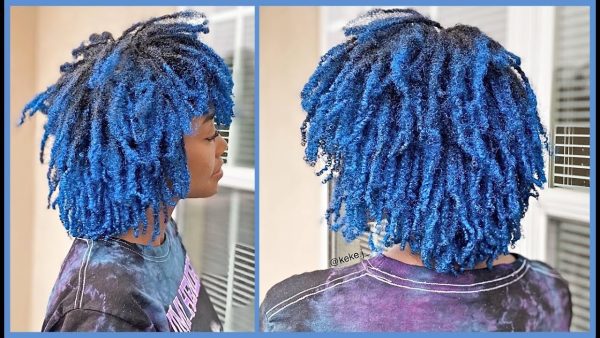
People love dreadlocks because they let you be creative with your hairstyle. What if you want to give your dreads a pop of color? Hair dye for dreadlocks can be a fun way to express yourself and add a touch of personality to your hairstyle. When you dye your dreadlocks, you need to be more careful than when you dye your regular hair because you don’t want to damage your hair.
Hair Dye For Dreadlocks
Dying your dreadlocks can be a fun way to express yourself, but you need to be careful to keep them healthy and achieve bright colors. When coloring dreadlocks, you need to be more careful than when coloring loose hair. If you don’t do it right, the tight bands can trap dye and make the color look uneven. Harsh chemicals can also damage hair and cause it to break.
Pros of Dyeing Dreadlocks
Dyes can be used to enhance style, camouflage grays, and showcase individuality, while also providing a youthful look and complementing personal aesthetics.
Cons of Dyeing Dreadlocks
Dyeing can cause hair damage, and color fading, and require regular touch-ups for vibrant color maintenance. Proper conditioning is essential to prevent hair damage and color fading.
Considerations Before Dyeing Your Dreadlocks
- Health of Your Hair: Before dying your dreadlocks, make sure they are healthy and not broken. Dreads that are already broken won’t hold the dye well, and the process could make them even worse.
- Color Choice: Since dreadlocks tend to hold onto dye more than loose hair, it’s generally recommended to go for a shade or two lighter than your desired color. Also, think about getting dyes that are only partially permanent and fade over time. This will make touch-ups easy and keep damage to a minimum.
- Do It Yourself or Hire a Pro?: It is possible to dye your dreadlocks, especially if you have done it before, but hiring a professional who knows how to do it can help you get a perfect product without any damage.
Choosing The Right Dye
Hair dye for dreadlocks can be divided into synthetic and natural options. Synthetic dyes are the most common and come in various colors, but can be harsh and cause damage if not applied correctly. Natural dyes like henna, which provide a reddish-brown hue, are gentler but have limited color options compared to synthetic dyes.
The Dyeing Process
Keeping in mind how important it is to put healthy hair first, here is a full explanation of how to dye dreadlocks:
Pre-dyeing (one to two days ahead of time)
- Washing and Conditioning: Use a cleansing shampoo to wash your dreadlocks and get rid of any buildup of product or dirt. After that, use a deep conditioner made just for dreadlocks to make sure they have the right amount of wetness.
- Test for allergies: Do a strand test on a small piece of hair that won’t draw attention to itself to see if the dye makes you allergic. Put a little of the dye mix on the fabric and wait for the time that was given. Rinse the area well and check for any discomfort for 24 to 48 hours before applying the full amount.
- Sectioning: Use clips or hair ties to separate your dreadlocks into parts that are easier to handle. This makes sure that the dye is spread evenly and that no spots are missed.
The Dyeing Method
- Gather rubber gloves, oil jelly, mixing bowl, brush, natural or synthetic color, and plastic tape for dyeing dreadlocks. Keep the workspace safe and cover it with towels or a plastic sheet to prevent dye from getting on clothes or surfaces.
- Put on Petroleum Jelly around your ears and neck to keep from getting stained.
- Prepare the Dye by following the directions on the dye’s package to mix it. Pay attention to the right mix of developer and dye, because mixing them wrong can change the color and hurt your hair.
- Apply the dye by carefully painting the dye mixture onto each dreadlock one area at a time. Do not oversaturate the hair. Instead, start at the root (the new growth area) and work your way down the length. Make sure the dye gets into the core of the dreadlocks by using the application brush or bottle.
- Set a Timer. The dye’s directions will tell you how long to process the dye. This will depend on the type of dye, the level of color you want, and the color of your hair before you dye it.
- It is important to monitor the color. You can check a small test area every so often during processing to see how the color is changing. Don’t over-process your hair, as this can hurt it.
- After working, rinse dreadlocks with cool water to remove excess dye and use a gentle shampoo to remove any remaining dye residue, as harsh soaps can remove color and wetness.
- Use a deep conditioner that is made just for dreadlocks. After the suggested amount of time, wash your face well. Deep conditioning helps restore the wetness that was lost when the hair was dyed.
Post-dyeing Care
- Wash your dreadlocks less often to keep the moisture in and keep the color from fading. When necessary, use a mild shampoo that doesn’t have sulfates.
- Deep Condition To keep your dreadlocks moist and stop them from breaking, deep condition them every so often.
- Be careful when using heat-styling tools like hair dryers and curling irons on your hair. Heat can hurt it and make the color fade. If you can, let your hair dry in the air.
- Protect your dyed dreadlocks from sunlight. UV rays can also fade colors. When going outside for a long time, you might want to wear a hat or use a leave-in conditioner that protects against UV rays.
- The color might fade over time. To keep the color vibrant, you can use color-depositing cleansers or get touch-ups from a professional.
Frequently Asked Questions and Answers About Hair Dye For Dreadlocks
1. Can I dye my dreadlocks?
Absolutely! Dyeing dreadlocks is a popular way to add color and personalize hairstyles, but requires a different approach compared to regular hair dyeing.
2. What kind of dye should I use for my dreadlocks?
Synthetic dyes provide a wide range of vibrant colors but can be harsh on hair, while natural dyes like Henna are gentle on hair but have limited color options.
3. How is dyeing dreadlocks different from dyeing regular hair?
Dreadlocks require dye to penetrate their core for even coloring, and application techniques and aftercare vary to ensure healthy, vibrant dreads.
4. What are the steps involved in dyeing dreadlocks?
The process involves prepping hair, mixing dye, applying it, letting it process, rinsing thoroughly, and following proper aftercare routines like deep conditioning and minimal washing.
5. How can I maintain the color of my dyed dreadlocks?
To maintain vibrant colors, avoid excessive washing, deep condition regularly, avoid heat styling, and use color depositing conditioners or touch-ups.
6. Are there any risks involved in dyeing dreadlocks?
Avoid harsh chemicals and improper application to prevent hair damage. Follow dye instructions, conduct strand tests for allergies, and seek professional advice if unsure.
Conclusion
Dyeing your dreadlocks is a fun way to show who you are and make your style more unique. Dreadlocks can look healthy and bright if you use the right dye, apply it carefully, and take care of your hair afterward. But it’s best to talk to a professional hairstylist for personalized help and to make sure your hair stays healthy while it’s being dyed.

Leave a Reply